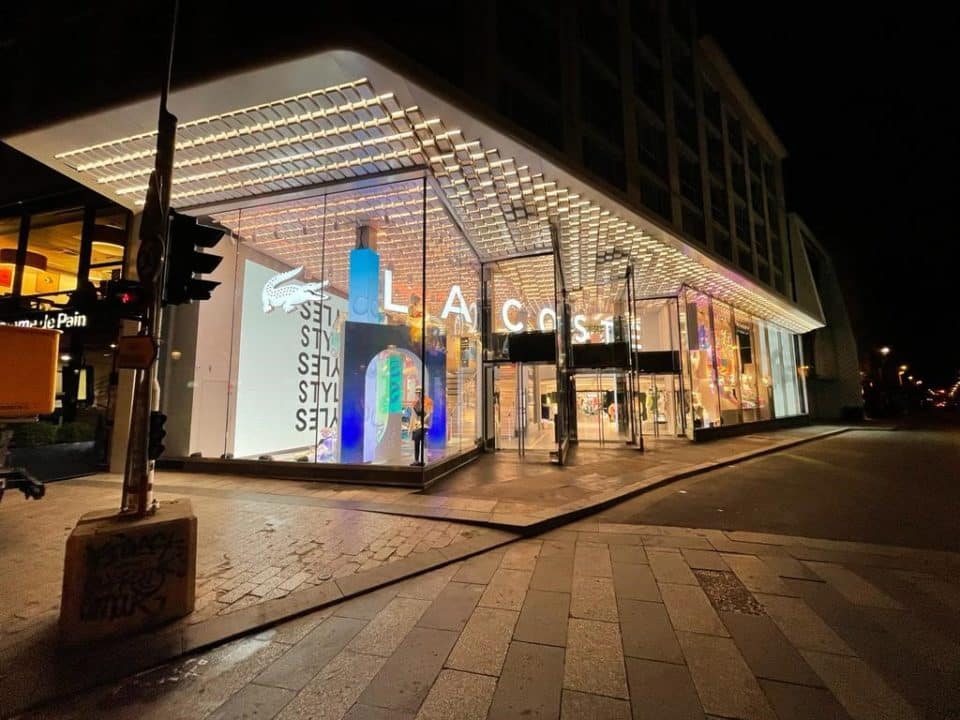Could Perch turn the store into a valuable data source?

Perch believes that every product tells a story.
However, it’s not always easy for products to tell that story when they’re sitting on a shelf.
Perch’s interactive display technology and smart shelves are helping change that. Brands can now bring the sort of digital assets, from videos to reviews and ratings, that customers are familiar with online into the store.
In turn, it’s giving brands an opportunity to truly understand what is happening in the store for the first time ever. Every product interaction is captured to help brands understand which are converting and which are struggling.
We spoke to Perch CEO Trevor Sumner about cracking open the black box of physical retail to enter a new frontier of data – and what this means for store sales.
Trevor Sumner, CEO, Perch
What does Perch do?
We like to say that every product should tell a story.
We build interactive displays at retail, which use computer vision to detect what people are touching on the shelf and provide them with more information about products.
We are achieving 87% sales lift on average. We just did a case study with Unilever which showed 188% sales lift in skincare products in grocery.
We all know that shoppers need ratings, reviews, videos and other content to feel educated and confident in the buying decision that they’re making. We can bring rich media and applications to every product on the shelf without scanning a QR code, downloading an app, or doing something onerous that results in 90-95% usage drop-off.
Part of the secret sauce is thinking through new dynamics of in-store digital and the merging of physical and digital retail. When somebody picks up a product from the display, it makes a sound, so you draw attention from the physical action to the digital screen and make the connection. We often show a picture of the product on the screen to solidify the association, and then present the most effective media, often a video, ratings and reviews and complementary product recommendations.
We think that presenting the right product level message at the point of consideration is the future of digital engagement in store because it’s so seamless and personal to every product on the shelf – and the results bear that out at 10x the effectiveness of traditional digital signage, which in my mind is the banner ad of in-store retail.
Which areas of retail are you working in?
Our clients include brands such as Johnson & Johnson, Purina, Unilever, Invisalign and Estee Lauder.
We work in a lot of different categories where you can offer that digital experience along with the physical product discovery, and where the margins support digital program investment such as beauty, pets, baby, electronics and fragrance.
We’ve integrated our technology into everything from the metal shelving you find at a grocery store all the way to $30,000 custom cabinetry at a Jo Malone.
Recently, our fastest expanding categories are grocery and mass retail. What excites me is the ability to democratize this technology into mass retail at scale, which is much more complicated as it’s a less controlled environment and you measure success in the hundreds or thousands of stores.
In the past, we’ve worked with brands where their whole store network in the US is 50 stores. We’re now doing a 200-store trial with Purina, which will be the largest product-aware network of interactive displays in grocery and pets. This pilot could expand to 2,000 stores or 10,000 stores, which could fundamentally change Purina’s market position. When you can have that type of impact for a top 10 CPG company, it’s humbling.

What kind of data is Perch capturing about customer interactions in store?
There’s a great quote by W. Edwards Deming that I really love which is, ‘in God we trust, all others must bring data’.
85% of transactions occur in store. And yet if you’re a brand, you might see the number of people who come into store via IRI or Nielsen data and then you see the sales come out, but what happens in the store? No data at all.
Imagine managing an e-commerce site where all you have is unique visitors and sales, and you don’t know where anybody goes on your site or what they clicked on or what content is popular or anything – that’s physical retail right now. In-store is an opaque, black box to brands.
What is the planogram effectiveness? What content changes the shopper journey? Which products convert the best from pickup to sale? None of this data is available to brands and much of it’s not available for retailers either.
For the first time we can look at what’s actually happening in store – when somebody picks up a product in store, it’s like they’re clicking on it.
For example, when it comes to planogram design there is an axiom that says, ‘eye level is buy level’.
It’s kind of true, but it’s also not the whole story. We looked at our end caps, for example, and it’s true that the eye-level shelf shows a 27% increase in shopper engagement.
What blew the minds of our clients was that the edges of the end cap were more valuable than the top shelf. It was actually more valuable to be on the edge of the middle shelf or the bottom shelf than the centre of the top shelf. We could show this in the planogram design and interaction data.
Equally, if the data shows something is true for our Perch end caps, then it is probably also true for all end caps. As such, you can use Perch as a test bed for planogram design that you can then roll out to all your stores – Perch or non-Perch. We’re bringing the online content in, and then we’re bringing the data about what’s happening in the store and putting it in a framework that finally makes sense just like e-commerce data.
Which content elements drive the most sales uplift?
We’ve looked at the content that most impacts people. A good example is Macy’s Fragrance Bar, which was powered by Perch with just over 400 screens.
We had this big debate over whether we should include ratings or not. Do you need them when customers can just smell the fragrance? If they like it, that’s all that matters. Or so we thought… When we looked at the data though, ratings were the second most popular content after video.
One of the things we think about is what is the purpose of the digital experience at physical retail? What is the shopper friction? Is this experiential or informational? What are the pieces of information that people need to know? What are the questions they need answered to feel confident?
For example, we’re working with Johnson & Johnson using their Neutrogena Skin 360 tool. It takes a picture of your face and recommends products for your specific skin type. The friction in skincare is that it’s a highly fragmented and complicated category and you just want to know what’s the right product for you – and that’s really hard to do with 4-point print on the back of a package on a shelf with tens or hundreds of products.
We can really understand what moves the needle in ecommerce because we have testing suites to do A-B tests of different content and see which performs best. One of the bigger mistakes we see is that a lot of the technology that’s being brought in-store is through smaller pilots, so there’s not enough data to do that.
It’s encouraging to see brands and retailers are now opting to do larger trials and take advantage of scale. If you have 200 stores, you could do 100 stores with one type of content, 100 stores with different content, and compare the two. You don’t get derailed by a couple of stores with anomalies like promotions, out-of-stocks, geographic variation, etc.
How have things changed since Perch launched?
The biggest difference is our focus on data.
The data that we provide is a whole new frontier. If you ask a brand with 20 products on the shelf which ones convert the best, they’ll give you the sales numbers. But that’s sales, not conversion.
But when you ask them to rate their best performing products based on somebody picking a product up and considering it, they don’t know. How do they know if they’re putting the best converting products in the right places on the planogram?
If you just do it on the sales numbers, you don’t realise that this product isn’t selling because people aren’t picking it up, but because they may be picking it up and something about the packaging, pricing or merchandising means that they’re not going to buy it. We can now see that data. We are able to point out struggling products.
Another example is thinking through content. For example, Johnson & Johnson had a beauty product end cap that had Neutrogena with Kerry Washington and Aveeno with Jennifer Aniston at the top. At the bottom, they had a product launch for Clean & Clear, which didn’t have a spokesperson so they used Instagram influencers.
They asked us ‘how much does it hurt our conversion rates not to have a spokesperson for Clean & Clear?’ We ran a test using some Instagram influencers with around 5,000 followers, which drove a 20% higher conversion rate from pickup-to-screen and 10% higher conversion rate to sales .
The question then becomes ‘what if we switched everything to Instagram influencers?’. The answer is they saw a 10% sales lift and 20% digital engagement lift across all their products. That’s a massive discovery that meaningfully impacts their business.
But you can only see that if you normalise the pick-up perspective and get the conversion rate, otherwise you’re just operating on sales data. If you looked at the sales data Clean & Clear was the lowest performing because it was on the bottom shelf.
We know Instagram influencers tend to appeal more to Gen-Z and Millennials. So, what if the answer actually is that a Gen-X customer should see Jennifer Aniston and a Gen-Z customer should see an Instagram influencer? Now we have the ability to segment that data, to personalise those experiences and see what actually drives shopper behaviour – what gets them to pick up a product? What gets them to go from pick-up to screen? What gets them to go from pick-up to sale?
We’re really moving into this A/B and multivariate testing to tell customers in this predictive way, what the most optimal experiences are and auto-optimise the experience for each demographic. And this is data that can be used across every digital initiative.

Are you seeing any big changes happening around stores?
We’re seeing people rapidly introduce new infrastructure. 5G is starting to become a real transformative force. The IDC predicts that IoT will explode 10x in the next four years, because of some of these underlying foundational technologies and accelerants. I think it’s getting a lot better. It’s still not where it needs to be.
If you think about the origin of the word ‘store’, back in the day goods were transported on ships, they came to port and they needed to be put somewhere so that they could be sold. It’s a place where you “store” the products.
If you think about that, that’s what a lot of our stores are. They’re just shelves where you store the product. It’s not about a retail experience. It’s not about discovery and digital and engagement and all these other things we aspire to in a lot of retail categories.
I think we’re really at this fascinating precipice where that foundation is changing because the value is not the shelf space per se. It’s the connectivity. It’s the data. It’s the experience. It’s sales associates having product information. It’s personalisation. It’s all these things starting to come together for products to be able to be more than just sitting on the shelf. They can tell their story. Brands can connect with shoppers. Shopper can connect with retailers across channels. This is connected commerce.
What have been some of your most interesting learnings since joining Perch?
I think the complexity of the retail ecosystem and the difficulty in balancing the needs of retailers, brands, and shoppers and how to connect that triangle together.
I think we’re really great for the shopper. I think we’re really great for the brand. I think we haven’t done as great a job with the value proposition to the retailer until recently.
The retailer doesn’t care if they sell 87% more of one brand and 87% less of another. That’s net zero to them. They care about category lift. They care about other strategic things like loyalty and converting in-store shoppers to omnichannel shoppers.
I think the other piece of big learning is that the retail industry is really struggling from an organisational development perspective with how to align itself with technology and data in-store.
There are a lot of disparate groups within a retail business – this person cares about this piece of data and this person cares about that piece of data. It’s a continued learning experience for me to figure out the best ways to align them. I think of AI and data like electricity, it’s going to power a little bit of everything you do.
I think there are simple ways to unify that relationship and ownership. If the online people only care about the online and the in-store people only care about in-store, how do you build a programme? These worlds are colliding, so you’ve got to unify the incentives.
Technology has the power to solve these problems if structurally the organisations have the will and alignment to do so.
Are there any retail tech companies that you think are really innovative?
There’s a company in New York called Rilla Voice, which is miking up sales associates and listening into the conversations to improve customer interactions. It’s a great way to understand what’s happening in the store and good and bad staff experiences.
The downside of that is do you really want to have everybody listening to everything all the time? Do you want to go into a store where every conversation is being recorded? There are some privacy concerns there that I think they’re trying to work through.
Cooler Screens is a company in the digital display space which replicates the physical products in the coolers in their displays. They have really interesting technology. However, what I’m grappling with is who decides the future of the digital store?
To me, this type of digital signage is like banner ads. If you think of your store as an ecommerce site and you put up this banner ad which is super profitable, then you might add another and another, and then you realise that you’ve so detracted from the shopping experience because you’re making so much money on banner ads that the shoppers stop coming. I’m fascinated by who will control the future of digital engagement in-store and how to avoid that outcome.
I also like Theatro. They basically put a headphone and microphone in a sales associate’s ear, which is voice activated. So, if a customer asks ‘do you have this in red’, the associate can ask the system and it will automatically tell them the answer. If it can’t answer the question it will route the associate to someone who can.
What is next for retail?
I think we’re going to find out that a lot of what we think we know is just wrong and that we can fundamentally change the way we do things and do much better.
I’m reminded of the Carl Sagan quote, ‘do you think that the first fish that crawled onto the beach had any concept of fire?’ As we climb onto the beach of this black box of retail, what are we going to find? What are we going to discover? What new connections are we going to make? What new inspirations will be generated? I think this is really going to be the golden age of retail.
Discover innovations like Perch in action on an Insider Trends retail safari. Book your bespoke session now.



